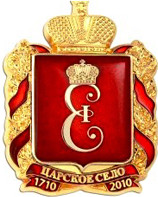
Tsarskoye Selo was founded
On June 24 (July 5), 1710 Peter I granted to his future wife Catherine Alexeevna Sarskaya Myza (country house) situated 25 km away from St. Petersburg. This day is considered the day of foundation of Tsarskoye Selo.
In the beginning of 18th century on the lands of the future royal residence had been a small Swedish country estate called Sarskaya Myza (a country house on an upland) in 1702 the territories were liberated by the Russian troops led by Peter’s I associates counts B. P. Sheremetev and P. M. Apraksin. After the Swedes had been banished, Myza, which now belonged to Governor General of the liberated region A. D. Menshikov, was named Sarskaya Selo. With the support of the Stable Affairs Office Menshikov started to organize a planned economy here and populated the estate and its outskirts with artels of carpenters and peasants. However in 1710 Peter I granted the lands to his future wife Catherine Alexeevna. The fact was mentioned in a letter of A. D. Menshikov to Larion Dumashev, the commandant of Koroporie, of June 24 (July 5), 1710: “His Majesty deigned to give to Catherine Alexeevna Sarskaya and Slavyanskay Myza of Koporie district along with villages, peasants and all lands which belong to them. Upon receiving this you should give to Catherine Alexeevna those country houses with villages and all the rest and discharge them from the register book”. From this day the formation of Tsarskoye Selo started.
When Peter I was still alive, Catherine Alexeevna founded in Tsarskoye Selo a small park around new stone palace and ordered to enclose it with paling, having allotted a part of the forest to menagerie. The park was planted with alder groves and fir alleys, fruit garden, greenhouses and hotbeds were installed there. The expansion of the Selo involved the growth of the employees and soon near the residence appeared a settlement. Structures which had been quite close to the imperial palace formed at first Sadovaya street, then Sluzhitelnaya and Malaya ones.
In 1728 the Empress’s estate passed into the hands of Elisabeth of Russia who started there an enormous construction. In 1741 Tsarskoye Selo became an official residence of Russian Tsars. In the second half of the 18th century not only the palace itself was erected with its main yard but also a park was lain out, hydraulic works were carried out and dwelling houses built.
In 1808 under the order of Emperor Alexander I the single town named Tsarskoye Selo was formed. Its reconstruction plan was designed by architect V. I. Heste. By the middle of 19th century the population of Tsarskoye Selo reached 14 000 people. Even then it was a well-planned town with railway service, water supply system, telegraph, telephone and radiostation.
By the beginning of 20th century Tsarskoye Selo was one of the most well-planned towns of the Russian Empire. After revolution the palaces and mansions of Tsarskoye Selo housed child institutions and the town itself was renamed correspondingly – Detskoye Selo (Child Village). In 1937 the town was renamed once more into Pushkin in honor of the centenary of the Russian poet’s death.
In 2000 Pushkin was the only Russian town awarded with a flag of honor of Europe.
Lit.: Бенуа А. Царское Село в царствование императрицы Елизаветы. СПб., 1910; Вильчковский С. Н. Царское Село. СПб., 1992; Ласточкин С. Я., Рубежанский Ю. Ф. Царское Село — резиденция российских монархов. СПб., 2000; Семёнова Г. В. Царское Село: Знакомое и незнакомое. М., 2009.
Царское Село: сайт. Б. д. URL: http://www.tzar.ru/.
Based on the Presidential Library’s materials:

